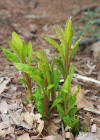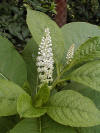WILD
FOODIES' HOME PAGE
PLANT PROFILE LIST
NAME: Pokeweed
SPECIES / FAMILY: Phytolacca Americana / Phytolaccaceae
OTHER COMMON NAME(S): Pokeberry, Inkberry
CONDITIONS:
sun/shade
|
PARTS: |
EDIBLE |
TASTE |
RAW/COOK |
SEASON |
|
All |
|
|
|
|
|
Shoots (young only) |
|
asparagus |
BOIL TWICE |
Spring |
|
Leaves |
||||
|
Stalk/Stem |
|
|
|
|
|
Buds |
||||
|
Flowers |
|
|
|
|
|
Fruits |
|
|
|
|
|
Pods |
|
|||
|
Seeds |
|
|
|
|
|
Nuts |
|
|
|
|
|
Roots |
|
|
|
|
|
Bark |
|
|
|
|
PORTION: small-medium
COMMENT:
Abundant plant, but must use with care. Very nutritious, tastes like
asparagus. Young green shoots must be boiled twice with new water each time.//
According
to Samuel Thayer, young shoots
should be green and tender, but not necessessarily less than 7” tall. In
fact, very young and short shoots can be red, which is not what you
want. //
The Green Dean recommends boiling the
leaves twice. First time one minute. Then change the water and boil for
another 15
minutes." (2)
CAUTION: All parts can be poisonous. Do not use if shoot is red. // Root and seeds are always poisonous. Some people are sensitive to handling the entire plant, so they should wear gloves. Avoid if pregnant. (1) (2) For more cautions:
-
https://www.verywellhealth.com/can-pokeweed-provide-health-benefits-4587368
-
https://stoneageman.com/deadly-poisonous-pokeweed-is-actually-edible-if-you-do-this
NUTRITION/MEDICINAL: “Alterative; Anodyne; Anti-inflammatory; Antirheumatic; Antiviral; Cancer; Cathartic; Expectorant; Homeopathy; Hypnotic; Narcotic; Purgative. Pokeweed has a long history of medicinal use, being employed traditionally in the treatment of diseases related to a compromised immune system.” (1)
LOOK-A-LIKES:
POISONOUS LOOK-A-LIKES:
OTHER USES: “Ink; Insecticide; Soap. A red ink and a dye are obtained from the fruit. A beautiful colour, though it is not very permanent. It makes a good body paint, washing off easily when no longer required, though the slightly toxic nature of the berries should be remembered. The rootstock is rich in saponins and can be used as a soap substitute. Cut the root into small pieces and simmer it in boiling water to obtain the soap. The plant is currently (1980) being evaluated for its snail-killing properties.”(1)
SOURCE LINKS (may include nutritional and medicinal info, plus other uses):
- https://www.pfaf.org/user/Plant.aspx?LatinName=Phytolacca+americana
- http://www.eattheweeds.com/can-be-deadly-but-oh-so-delicious-pokeweed-2
- https://en.wikipedia.org/wiki/Phytolacca_americana
- http://www.foragingtexas.com/2006/04/pokeweedpoke-salat.html (good photos)
- http://foragedfoodie.blogspot.com/2017/03/burdock-and-pokeweed-fritters.html (recipes)
- https://www.gardenista.com/posts/weeds-you-can-eat-pokeweed
- https://www.wildernessarena.com/food-water-shelter/food-food-water-shelter/food-procurement/edible-wild-plants/pokeweed
- https://www.wildabundance.net/blog/pokeweed
- https://thegrownetwork.com/pokeweed-berries
- https://www.timesmojo.com/what-happens-if-you-eat-pokeweed-berries




_small.jpg)